Doom: The Dark Ages is a bigger change for the series than I realised. This isn’t just a ‘Doom in the olden days’ reskin – Doom with a shield and a flail and a furry black Jon Snow cape – but a proper revision of how the series works. Ironically, given the setting, it’s also the most modern-feeling of the Doom games, with a much more pronounced story than we’ve had before, a greatly expanded character-upgrade system that borders on skill-tree territory, and open-zoned sandbox levels you can return to and explore at your own pace. This feels like an experience built from a thicker pitch document than we’ve ever had before. And while I both admire the desire for change, and acknowledge the need for it – Doom Eternal didn’t leave many places to go – I’m not entirely convinced about The Dark Ages yet. There’s undeniable Doom magic here but there are question marks too.
At the heart of the new game is the shield, your spinning-bladed new toy, which you receive from the beginning and which serves as a conduit through which all of the game’s new ideas run. The Dark Age’s mantra is “stand and fight” and it’s the shield that enables you to do that. You block with it, parry with it, reflect projectiles with it, throw it, smash walls and solve environmental puzzles with it, and you use it to propel yourself forward like a thundering missile. It is a tool you always have at hand and around which everything is built.
The shield brings a different rhythm to play. Doom 2016 and Doom Eternal were based around movement, around outrunning and outmanoeuvring enemies while you selected the best guns for dealing with them. But Doom: The Dark Ages feels more like Resident Evil 4, as you study the battlefield with your shield up and feet planted, prioritising which targets to take out first. Where are the weak points?
Where are the glowing green enemy attacks you can rebound with your shield with a loud metalling “bong!” if you time it right? Where are the big enemies whose leaping melee attacks you need to parry? Where are the superheated metal shields and armour you can destroy by flinging your shield at them? Are there any large enemies you want to stun by lodging your spinning shield inside them? Do you need to close a gap by shield-charging anyone, or obliterate a group of weaker enemies in the same way? The shield is at the center of it all.
And because the shield gets you in close, there are more melee options now for you to use. The chainsaw has gone – buzzed off (sorry) – so your trusty punch has been buffed to pick up some of the slack. It’s now a gauntlet that attacks in a punching sequence of three, as does the deliciously wicked flail – the spiked mace on chain – that you pick up later on. (I think there are even more melee weapons I haven’t seen, too.) Their three attacks means it’s possible to shield-charge into an enemy, hit them three times, and then glory-kill them if they’re hurt enough. That’s a potential string of five melee attacks in one devastating sequence, which feels radically different to attack patterns in the other recent Doom games. Melee combat in Dark Ages actually reminds me more of the Batman Arkham games and their rhythmical battles as you tumble around, parrying, destroying packs from within.
Glory kills return, then, although they’re changed slightly here. They still make enemies give ammo and health, but they don’t lock you into animations as rigidly as before, sometimes because the attack won’t outright kill the enemy in question. There are some beefy adversaries; with better defences come more sturdy foes, it seems.
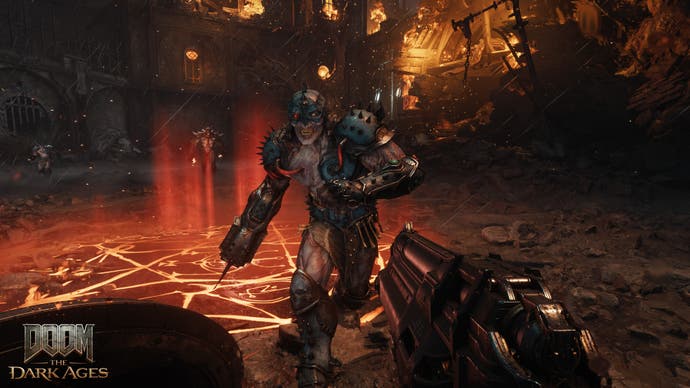
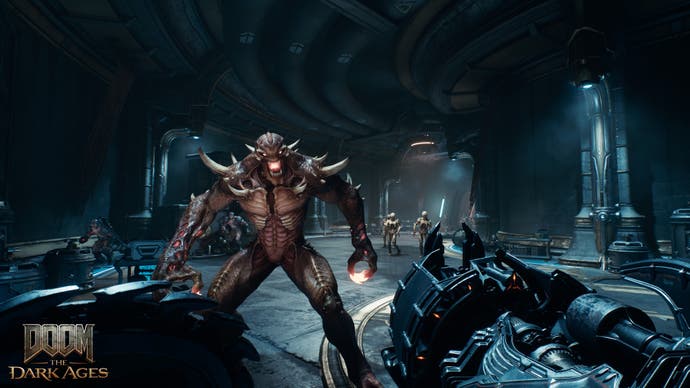
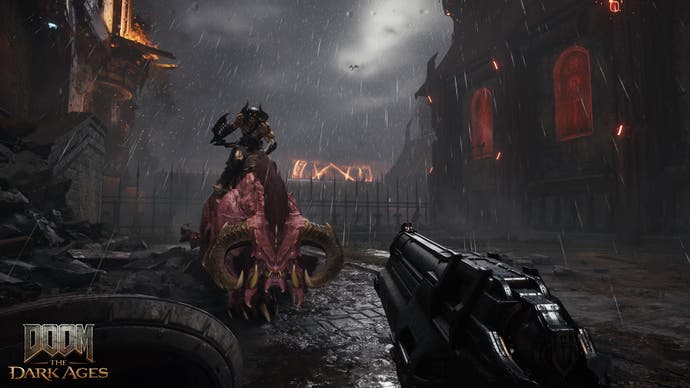
Around all of this is a refreshed arsenal showing wonderful imagination, and an expanded upgrade system to customise it with. More fundamental pieces of equipment such as the shield and gauntlet and flail can support several upgrades – the shield can do things like bounce around enemies if you want – but the guns usually only have a choice of three or four. It’s partly because there’s no alternate fire any more, because the shield overrode it, occupying the alternate fire button slot, so the choice with guns has become one of build synergy.
Do you want your rapid-fire bullets to ricochet from an enemy you’ve lodged your shield into onto a nearby crowd, for instance? Or do you want your bullets to superheat enemies so they’ll explode when you throw your shield at them? There are some enticing ideas there, and as a Diablo player, the concept of builds excites me.
A quick word on some of the guns: there are some you will recognise and some you won’t. There is, of course, a super shotgun, and it’s wonderful in the way id Software’s shotguns always are, exploding with thunderous force, but there are more unusual guns too, such as my early favourite, the cannonball-on-a-chain gun (that’s not the official name). This seems fairly innocuous when you use it, but oh my does that cannonball land with some force, thumping chunks of flesh off of enemies it collides with. It’s deliriously good fun, and feels almost like another melee weapon in use. I’m also fond of the rail spike gun, which launches metal stakes at enemy’s heads, if you aim them right, impaling them, and I’m morbidly drawn to the gun that crushes skulls into ammo and sprays a wide barrage of bullets a short distance, because it’s gruesome and because it makes enemies drop health, it seems. Very useful. They all support this ongoing idea in Doom that there’s a correct tool for each job, though it feels less pronounced as a concept than in Doom Eternal.
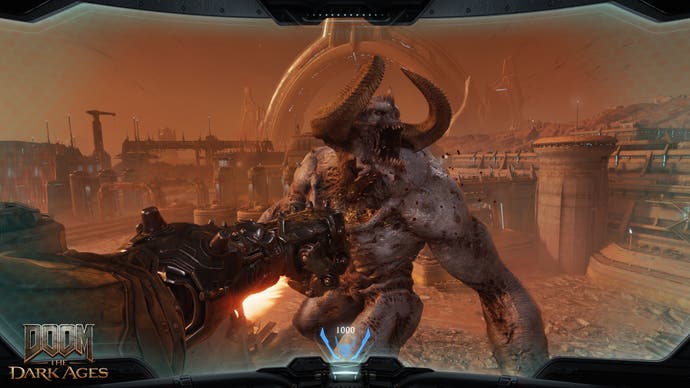
One aspect of The Dark Ages I’m not sure about are the sandbox levels, which represent a major deviation for Doom because they hand the tight pacing of the series over to the player. I found the tempo was noticeably different on the level I played, Siege, as I roamed around tackling clusters of enemies and solving environmental puzzles, and tussling with new mini-boss events. These have you clear waves of enemies that effectively shield a boss, meaning you have to get rid of them before you can damage it, and these encounters were tough. So while there were moments of great intensity, there wasn’t the focus or pacing overall that the authored, scripted levels have. And I don’t dislike this. A break from the headlong charge of Doom’s campaigns is very appealing, as is the opportunity to dig around for upgrade resources and try out new builds. It’s also worth noting these sandbox levels are optional – that’s what we were told in a presentation before playing – but how optional, I don’t know. I expect maybe you’ll play some of the level and then be allowed to leave, with the option of staying or returning if you want to. It’s an interesting development, but I worry that if these sandbox levels are overused, they could bloat the game.
Similarly, I wonder how often we’ll be riding dragons and piloting mega-mechs in the game, because from my brief experience of them, neither was particularly fun. They were to begin with: they’re incredible wish fulfilment introduced in quintessentially Doom ways – the dragon’s arrival in particular made me giggle with glee – but after 10 minutes, I’d had enough and longed to be back on the ground.
The problem these sections have is a lack of detail in comparison to the moment to moment action of on-the-ground Doom, and the sadistic toolbox of destruction available to you there. They feel a bit like mini-games. The dragon section plays like a limited shoot-’em-up, where you fly forwards and shoot a rapidfire cannon mounted on the dragon’s back, though it holds you up with a ‘lock onto enemies and dodge their projectiles’ mechanic in most combat encounters. And the Atlan mech plays like a glossy action mobile action game, limiting you to punching or dodging and occasionally zapping an Iron Man-like palm laser. Even equipping a gigantic chaingun doesn’t change the rhythm much. There aren’t enough ideas in either for them to feel fun for very long. Plus, their inherent sense of scale also fades quickly in play; the dragon loses size as the camera zooms out to frame it, and the Atlan mech, because it’s played in first-person, just feels like the rest of Doom, only less interesting.
Perhaps these sections will evolve over the course of the full game – I don’t know. But if they’re used too much, they could quickly overstay their welcome.
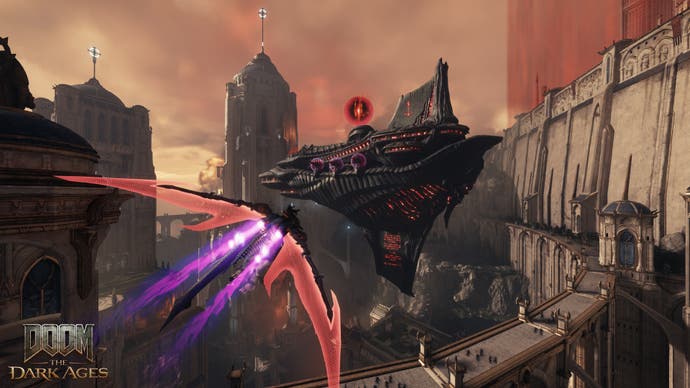
I’m not sure what to make of the abundance of story yet, either. I’m fascinated by Doom Slayer’s growth as a character since Doom 2016, and this idea that Hell, the scariest place humans can imagine, is full of creatures scared of him. But the story has never been this overt before. In Doom Eternal, cutscenes were used as a way of showcasing a boss before a battle, or to deliver dollops of lore here and there. But in The Dark Ages, Story has a capital S, and you’ll watch longer scenes where named characters present a storyline to you.
A lot of this is very enjoyable. The cutscenes are lavishly realised and the characters are glorious in their twisted design, and it all firmly reinforces the fantasy of you, the Slayer, being a terrifying weapon (audio barks to the effect of “We need him!” and “Deploy the Slayer!” and “The Beast is tearing through our ranks again!” made me smile), but it feels noticeably different having a story told like this, and again, I wonder how it will feel across the full game.
Another concern I couldn’t shake about The Dark Ages came from a feeling of sluggishness in control, which I didn’t expect after the silky smooth Doom Eternal. Some of this has to do with the heft of the new Doom Slayer, whose footsteps are thumping stamps and who lands like a meteor, but I suspect another part of it has to do with tuning. Given id Software’s expertise, though, I’m confident any tuning issues will be addressed by the game’s launch in May, and I didn’t hear of anyone else having issues with a similar thing. Still, I’d be remiss not to mention it.
Actually, it’s id Software’s expertise that I keep coming back to, and how nice it is that it not only successfully resurrected Doom in 2016, much to many people’s surprise – mine included – but how it’s been given time and resources to develop it, to reimagine it, since. This is a bold reimagining, a brave departure, and even though I have reservations about some things in The Dark Ages, I do not have reservations about id.
This preview was based on a press trip for which Bethesda paid travel and accomodation.
Source link










Add comment